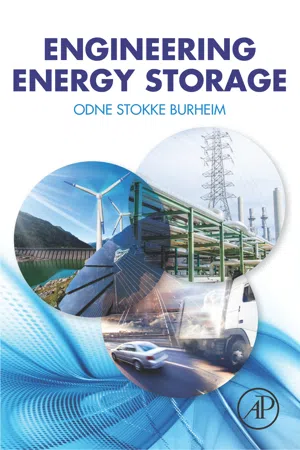
- 252 pages
- English
- ePUB (mobile friendly)
- Available on iOS & Android
Engineering Energy Storage
About this book
Engineering Energy Storage explains the engineering concepts of different relevant energy technologies in a coherent manner, assessing underlying numerical material to evaluate energy, power, volume, weight and cost of new and existing energy storage systems. With numerical examples and problems with solutions, this fundamental reference on engineering principles gives guidance on energy storage devices, setting up energy system plans for smart grids. Designed for those in traditional fields of science and professional engineers in applied industries with projects related to energy and engineering, this book is an ideal resource on the topic.- Contains chapter based numerical examples, with applied industry problems and solutions- Assesses underlying numerical material for evaluating energy, power, volume, weight and cost of new and existing energy storage systems- Offers a cross-disciplinary look across electrical, mechanical and chemical engineering aspects of energy storage
Frequently asked questions
- Essential is ideal for learners and professionals who enjoy exploring a wide range of subjects. Access the Essential Library with 800,000+ trusted titles and best-sellers across business, personal growth, and the humanities. Includes unlimited reading time and Standard Read Aloud voice.
- Complete: Perfect for advanced learners and researchers needing full, unrestricted access. Unlock 1.4M+ books across hundreds of subjects, including academic and specialized titles. The Complete Plan also includes advanced features like Premium Read Aloud and Research Assistant.
Please note we cannot support devices running on iOS 13 and Android 7 or earlier. Learn more about using the app.
Information
Energy Storage
Abstract
Keywords
1.1 A Brief History of Energy
Table of contents
- Cover image
- Title page
- Table of Contents
- Copyright
- Preface
- Chapter 1: Energy Storage
- Chapter 2: General Thermodynamics
- Chapter 3: Mechanical Energy Storage
- Chapter 4: Thermal Energy Storage
- Chapter 5: Thermomechanical Energy Storage
- Chapter 6: Electrochemical Energy Storage
- Chapter 7: Secondary Batteries
- Chapter 8: Hydrogen for Energy Storage
- Chapter 9: Supercapacitors for Energy Storage and Conversion
- Appendix A: Symbols and Constants
- Appendix B: Adiabatic Compression of Air
- Appendix C: Para- and Ortho-Hydrogen
- Bibliography
- Index